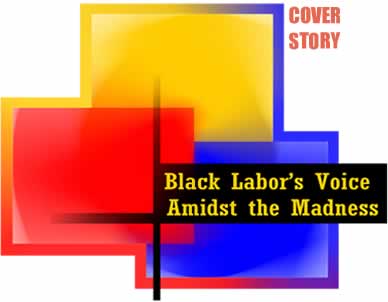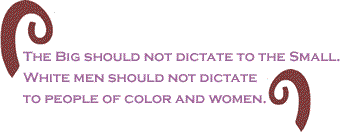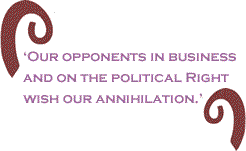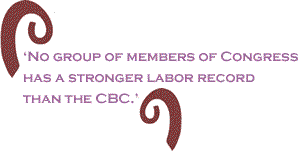
|
|||||||||||||||||||||
|
For the first time since one faction of the AFL-CIO declared war on the other nearly a year ago, Black trade unionists from across the U.S. and Canada will gather later this month in an attempt to force the contenders for control of the labor federation to recognize the interests of African Americans. “We…have a responsibility to make our voice heard in the crucial debate taking place now on how to make the labor movement broader, more powerful and more relevant to the lives of working families, especially in communities of color, the fastest growing sector of the labor force,” said Bill Lucy, President of the Coalition of Black Trade Unionists. The CBTU, with 50 chapters in 50 unions, holds its 34th annual convention in Phoenix, May 25 – 30, under the theme, “Forging a New Vision for Tough Challenges Ahead.” With Big Labor getting smaller all the time, and the corporate regime in Washington bent on, in TransAfrica Forum executive director Bill Fletcher’s words, the “annihilation” of the union movement, the term “tough challenges” seems an understatement. “They are not talking about simply the reduction of our numbers or power,” Fletcher told a caucus of Black unionists in April, “but our total elimination.” The language of apocalypse and fratricide dominates labor discussions, as Service Employees International Union (SEIU) chief Andrew Stern and four allied union presidents, representing about 40 percent of the AFL-CIO’s membership, ratchet up their campaign to drastically restructure the labor federation – or leave it altogether. "This is not organized labor. This is disorganized labor," exclaimed the SEIU’s Stern on May 10, laying labor’s continuing decline at the feet of AFL-CIO President John Sweeney. The dissidents’ “Unity” conference, in Las Vegas, hosted by Teamsters chief James Hoffa, Jr., also included the leaders of the Laborers, United Food and Commercial Workers (UFCW), and the hotel, restaurant, and laundry workers' union, Unite Here.
"The American labor movement at the level of the AFL-CIO has lost its way,” shouted Unite Here president John Wilhelm, who may be the Stern-Hoffa group’s designated challenger for Sweeney’s job at the federation’s annual convention, in July. “It's lost its energy. It's lost its hope. And that's a crime," Wilhelm shouted. The Teamsters' Hoffa railed against “bottom-feeding unions…like the Machinists that are out there trying to steal our members from the Teamsters, with lower, sweetheart contracts." So vitriolic was the rhetoric in Las Vegas, it sometimes appeared the dissidents were determined to achieve a “unity” of intra-labor hatred. The week before the verbal pyrotechnics in Las Vegas, four of the union presidents – minus the UFCW chief – demanded that AFL-CIO headquarters in Washington delete their members’ names from lists used to coordinate political campaigns. Off the record, aides to the union presidents complained that the federation was sharing the lists with Democrats. In an attempt to mollify the opposition, AFL-CIO president Sweeney terminated the jobs of one-third of the headquarters staff – 167 employees. For them, the Apocalypse had already arrived. But Stern, Hoffa & Company were unrelenting. Writing in the dissidents’ UniteToWinBlog, Stern called Sweeney’s firings and other counterproposals “Unite To Win Lite,” – a pale version of his own 10-point program – and made plain that he’s out for Sweeney’s head:
No Labor revival without Blacks If it sounds like the Sweeney and Stern camps have reduced Black labor to mere spectators to this very uncivil war – it’s because that has been both sides' intention. Sweeney did not consult with labor’s constituency groups before firing one-third of the federation’s staffers. And it was under Sweeney that labor’s ethnic and gender constituencies, including the 33-year-old Coalition of Black Trade Unionists, were utterly frozen out of participation in the 2004 election cycle – zero-funded, in favor of 527s and other white-controlled mechanisms.
Structurally, the opposition’s plans were perceived by Black labor to be a coup de grace, as BC wrote in our March 3, 2005 Cover Story, “No Real Labor ‘Reform’ Without Blacks”:
An early March meeting of the federation’s Executive Council produced informal assurances to Blacks that labor’s constituency organizations would not be shunted aside, and that local structures would be strengthened, should Sweeney survive the July convention, in Chicago. But the Stern-Hoffa camp offered no structural mechanisms to non-whites, only the promise that workers of color would benefit most from the remake in the long run – the same message that the SEIU’s Black vice president, Gerald Hudson, conveyed in his February 24 letter to BC, “Rebuilding the Union Movement to Empower Communities of Color.” “We need leaders and activists at all levels of the union movement who reflect the membership in terms of race, gender, and other factors,” Hudson wrote – but not a word about institutional Black and brown representation in the corridors of union power. Questions in Stern’s ‘own house’ In the second week of April, the Black caucus of Andrew Stern’s own union held a conference in Las Vegas – the first opportunity for AFRAM’s full leadership to discuss the implications of “reform” since June of 2004, when the SEIU’s annual convention gave Stern authority to withdraw from the AFL-CIO if he chose.
A number of papers circulated among the 400 Black caucus delegates, including BC’s March 3, 2005 Cover Story, a paper by a group that included TransAfrica’s Bill Fletcher, and Black labor consultant Dwight Kirk’s February 24, 2005 BC article, “Can Labor Go Beyond Diversity Lite.” Kirk’s article revealed that “55 percent (or 168,000) of the union jobs lost in 2004 were held by black workers” and “African American women accounted for 70 percent of the union jobs lost by women in 2004.” Nevertheless, voters of color remain the most likely to support the AFL-CIO’s “Take Back America” agenda. Yet “a decade after black trade unionists successfully thrust color and gender into labor’s last major leadership ‘makeover’ they and their allies are now on the defensive, fighting to protect past diversity gains from the knives of some new ‘reformers.’” Bill Fletcher, paired as a Sunday speaker with SEIU executive vice president Tom Woodruff, delivered a stark analysis: “Our opponents in business and on the political Right wish our annihilation. They are not talking about simply the reduction of our numbers or power, but our total elimination” In the face of such dangers, the split in labor amounts to “a train wreck,” said Fletcher, a former AFL-CIO operative:
Fletcher received a standing ovation from most of the delegates, while Woodruff, who kept largely to Stern’s 10-point program, got polite applause. Stern did not attend the meeting of his union’s Black caucus, but emissaries of both warring camps circulated among the members. Stern’s lobbyists pressed AFRAM to hold back on any resolution, since the Black caucus could be expected to express grave concerns about Black constituent clout in the “reformed” AFL-CIO. Representatives of SEIU leadership passed the word that elimination of constituent representation and funding was “off the table” – but this is a war of positioning, and it remains unclear what “off the table” means. On the morning of Monday, April 11, while the AFRAM conference was still underway in Las Vegas, Andrew Stern, Woodruff and other senior SEIU officers posted a letter on the UnitedToWinBlog, in response to Dwight Kirk’s research on the decimation of Black union workers:
The letter descends further into what is now SEIU boilerplate: “A deliberate policy promoting real empowerment, not just symbolic diversity, has changed our [SEIU] International Executive Board so that it is 40 percent female (compared to 56% of our membership) and 33 percent people of color (compared to 34% of our membership) – no cause to rest on our laurels, but real progress.” In other words, trust our example (and our numbers), but don’t expect structural inclusion in the New AFL-CIO. Wall of White Noise “Let me say that it would be a serious ‘omission’ for any of the sincere and articulate advocates of reform to assume what is in the best interest of black trade unionists and the coalition partners with whom we work regularly,” said CBTU president Bill Lucy, as he prepared for the organization’s May 25 – 30 convention, in Phoenix. Embattled AFL-CIO chief John Sweeney and Rev. Jesse Jackson are scheduled to speak at the affair. Blacks confront an environment in which elements of both white male-dominated labor camps appear to believe that minority constituency representation, and empowerment of largely Black and brown big city labor councils, is something the New AFL-CIO can do without. At times, this attitude is manifested in pure racial arrogance, immediately recognizable to all African Americans. In early May, the SEIU’s white Secretary-Treasurer, Ann Burger, shot off a letter that must rank among the worst racial indiscretions committed by union officials in recent years.
“The SEIU is expressing our displeasure that the Congressional Black Caucus is giving Wal-Mart an opportunity to fashion a false image that they are friends of African Americans and working people generally,” wrote Burger. Wal-Mart is currently on a public relations and lobbying offensive, courting constituencies all over Capitol Hill, including the Black Caucus. It is true that a growing minority in the Caucus is open to contributions and propaganda from Wal-Mart, the evil engine of America’s – and the world’s – race to the bottom. (See BC, April 28, 2005 and May 12, 2005.) But the SEIU’s broadside at the Caucus as a whole was so ill-aimed, it was inevitably perceived as racist or incompetent – or both, as the newspaper The Hill reported:
In other words, the white leadership of the SEIU doesn’t know how to talk to Black people. It is such arrogance, almost as much as the depredations of the Bush regime, that may be the death of organized labor in America. Labor’s color line Even as unions struggle to respond to forces bent on their annihilation, they remain deformed by racism – the same plague that has crippled the U.S. labor movement at every stage in its history. Black workers, the most enthusiastic “joiners” and activists, also face the most dire consequences of labor’s historical weaknesses. Yet, too often, their white comrades – including those who proudly consider themselves “progressives” – seek “solutions” to labor’s problems at Black workers’ institutional expense. Labor, not so big anymore, has to get its mission straight, as the CBTU’s Bill Lucy pointed out, in January:
Three principles should guide labor’s deliberations: The Big should not dictate to the Small. White men should not dictate to people of color and women. And local struggles should not be subordinated to top-down union management. In the New AFL-CIO envisioned by some, top-down union management will also be near lilly-white. That’s what got us into this mess, in the first place. |
Your comments are always welcome. Visit the Contact Us page to send e-Mail or Feedback or Click here to send e-Mail to [email protected] e-Mail re-print notice
If you send us an e-Mail message we may publish all or part of it, unless you tell us it is not for publication. You may also request that we withhold your name. Thank you very much for your readership. |
| May 19 2005 Issue 139 |
|||||||||
|
|||||||||
|
|
|||||||||
| Printer Friendly Version | |||||||||
 |
|||||||||
 |
|||||||||
| |
|||||||||
| |
|||||||||






























